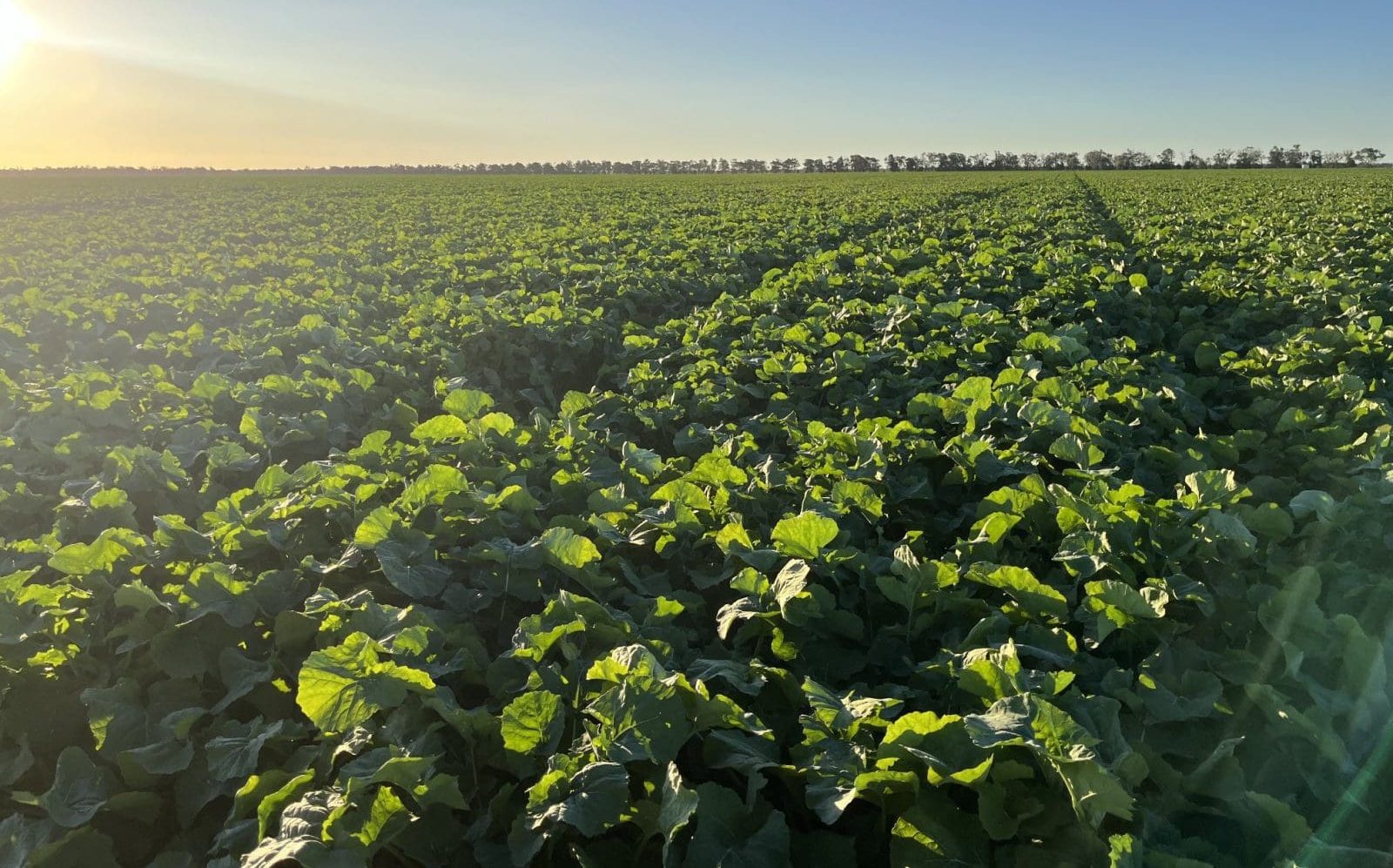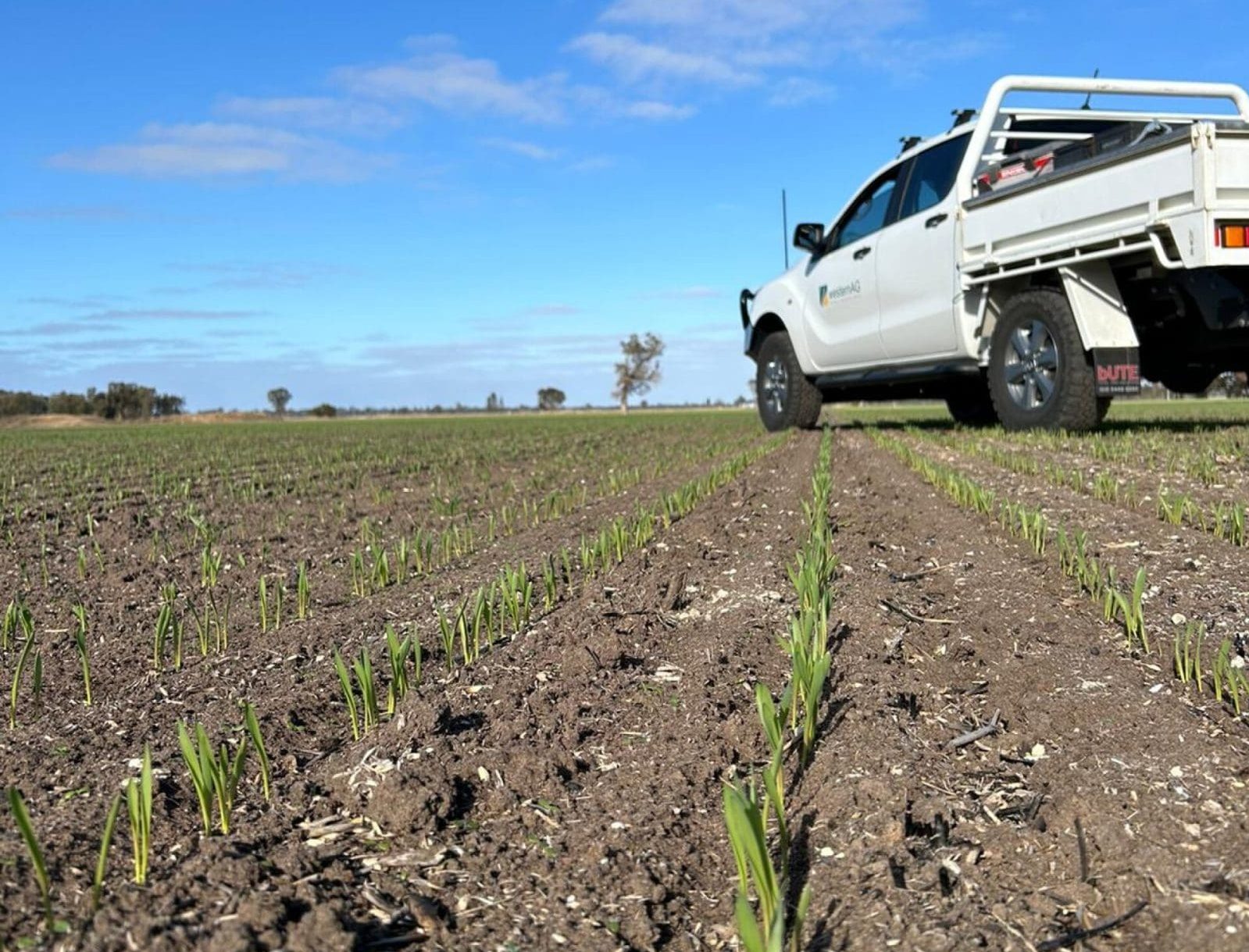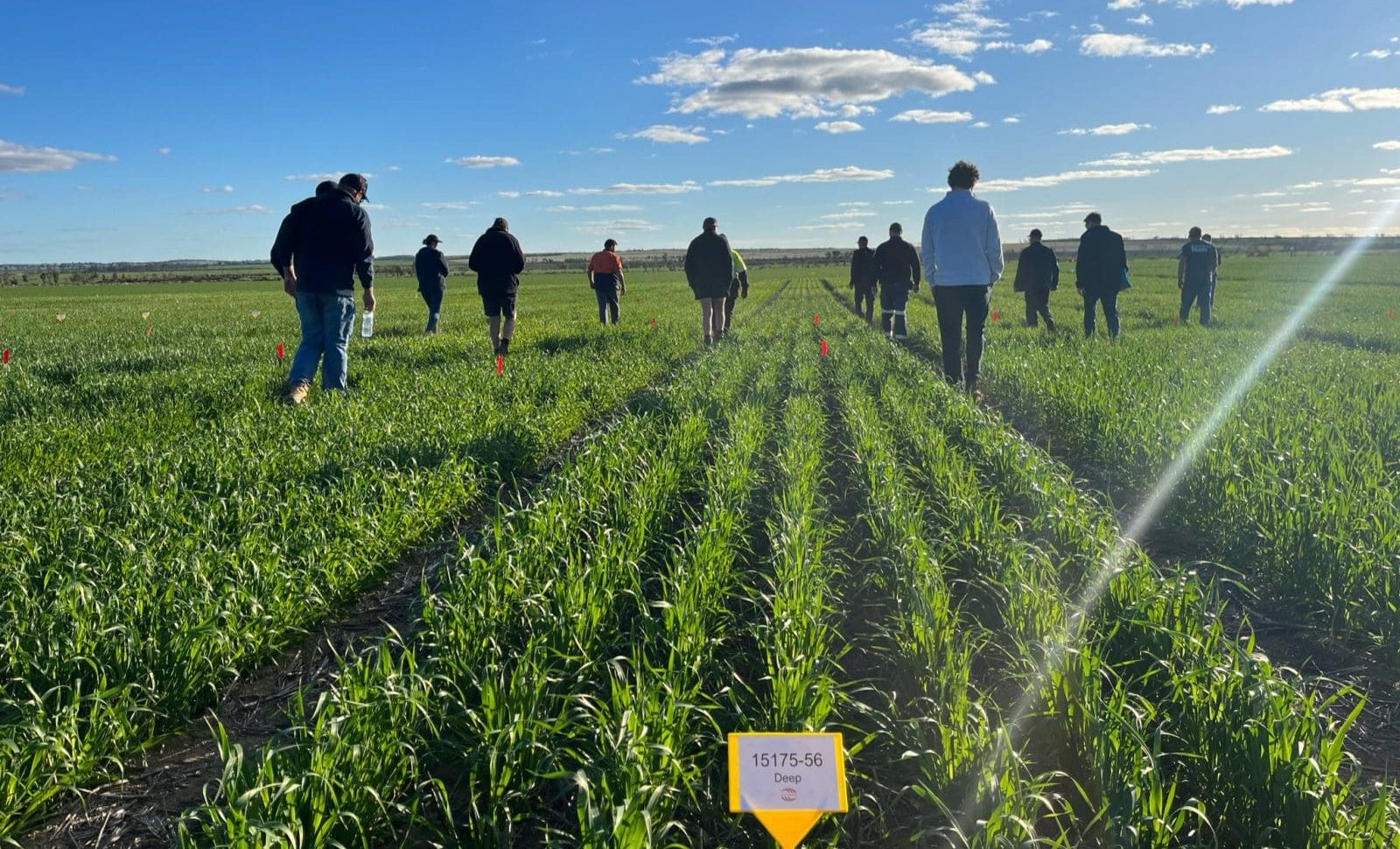
A thriving crop of canola in NSW near the Qld border at Mungindi shows off the best of the northern season. Photo: Sam Heagney
ALMOST all of Australia’s winter crop is up and away, with the patchy start in much of Victoria, South Australia, and Western Australia the wild card for production.
As we enter the depths of winter, cold weather is arresting crop growth, and giving growers time to top-dress with urea in order to get the maximum yield benefit from showers scudding through.
In summary, southern Queensland and New South Wales crops are on track for an above-average season, and the final paddocks of chickpeas are getting planted to close off sowing.
Conditions in Victoria and Western Australia vary widely, with some crops powering away after a timely plant, and plenty of others only at the three-leaf stage.
South Australian cropping regions have received good rain this month, but crops in SA’s South East, and the adjoining Western District in Vic, are lagging in what for some districts has been the driest first half of the year since 1967.
Graziers in these regions have become volume buyers of grain, pulses and hay, and if their crops now in the ground return below-average yields, as is highly possible, they will buying in feed for months to come
Overall, Australia is still seen as having potential for an above-average season, provided the crucial month of September brings mild weather and good rain.
Latest official estimates for Australia’s 2024-25 production were released by ABARES on June 4, and put wheat at 29.1 million tonnes (Mt), barley at 11.5Mt, and canola at 5.4Mt.
Major pulse crops are seen at 1.6Mt for lentils, 1.15Mt for chickpeas and 550,000t for faba beans.
Queensland
Rain at planting time failed to show up for much of Central Queensland.
This has had no impact on area for chickpeas, which were planted at depth into subsoil moisture, and will benefit from rain now falling in the region.
Emerald AGnVET agronomist Patty McMillan said chickpeas are off to a good start.
“There’s not much wheat in, but a lot of people have planted chickpeas,” Ms McMillan said.
“It’s been very dry until today, and showers will help things along.”
In southern Queensland, AgForce Grains president and Warra grower Brendan Taylor said winter cereals were well established and looking “a picture”, while chickpeas were just starting to germinate.
“The Downs is in very good shape; that’s not to say we wouldn’t take a shower of rain now, which the forecast says we’ll get in the next few days,” Mr Taylor said.
Planting of chickpeas is now drawing to a close.
“Most chickpeas are just about to come out of the ground; even those planted at as little as 50mm are taking a week to germinate because it’s very cold.”
New South Wales
As with southern Qld, above-average yields are seen as possible, if not likely, for winter crops, provided growers can manage weeds, disease, and nutrition, and spring is kind.
At Moree, B&W Rural director and agronomist Peter Birch said some growers were planting their last paddock or two of chickpeas in mostly ideal conditions to finish their winter sowing program.
“It’s good everywhere,” Mr Birch said.
“We’ve had a few frosts in the past week which will settle things down, because the crops have been seriously growing.”
Mr Birch said a large amount of urea has just been delivered to Moree, and is being spread ahead of rain forecast for coming days.
At Parkes in the Central West, PY Agronomy principal Peter Yelland said crops were generally planted at the ideal time, and are off to a strong start.
“Grazing crops went in on time, if not slightly early, and they’ve been producing really really well,” Mr Yelland said.
In a flip of the normal situation, the Central West’s outer slopes and plains are a little too wet in places, while the inner slopes could do with some rain ahead of spring.
“East of the Newell Highway, rain dropped off, and there’s not a lot of feed and water for stock.”
Victoria
At Swan Hill in north-west Vic, Terra Ag agronomist Ben Pumpa said Mallee crops have germinated, but growth is slow amid the frosty conditions and short days.
“Everything’s out of the ground,” Mr Pumpa said.
“Depending on soil type, heavier soils waited for heavier rain before crops went in, but a lot of country was sown dry.
“Most cereals are at the three or four-leaf stage, and some are just coming out of the ground.”
In the Wimmera, Nutrien Ag Solutions Rupanyup-based agronomist Brad Jackson said late-emerging crops were catching up to earlier ones prior to the run of cold weather.
“We’ve had some very patchy emergence, and a lot of cereals and pulses have come out of the ground in the past 5-7 days,” Mr Jackson said.
“West of Horsham, it’s probably their worst start for a very long time, maybe since the ’60s, and south of Horsham… there’s hay and grain going to graziers.”
“I’ve been in the industry for nearly 20 years, and it’d be the most staggered start I’ve seen.”
Mr Jackson said subsoil moisture reserves were generally good, and crop success will rely on roots not getting stranded above it.
“Seeding depth has been critical; some people went too deep, and it’s made a dramatic difference.”
He said urea is available, and is being spread ahead of forecast rain.
“Even though we are late…we could still have an average year.”

A crop of Neo barley not long out of the ground in Victoria’s Wimmera district. Photo: Western AG
South-west Vic, including the prized Western District grazing region, is where the greatest moisture deficit can be found.
Bannockburn-based Western AG agronomist Ashley Perkins said dry conditions were concerning for croppers and graziers.
“For this month, we’ve had 6mm so far, when 50-75mm a month is not unusual for this time of year,” Mr Perkins said.
“It’s very ordinary at the minute, with staggered germination, and crops where we don’t know if they’re going to come up until we get 10-15mm of rain.
“Cereals are okay, but canola is patchy, and beans are patchy.”
While dry sowing is commonplace in north-west Vic, it is a rarity in the south-west.
“We sowed a lot of crops dry, and on minimal moisture, and we need some rain very very shortly.
“If crops don’t come up, maybe some late barley will go in.”
South-west Vic is renowned for its long and mild springs, and Mr Perkins said spring barley was therefore a good option for growers to have if dry-sown crops fail, and if a desperately needed 20mm or more falls soon.
South Australia
SA’s cropping regions have jagged some good rain this month, but its South East, which is a grazing and mixed-farming district, is behind due to its colder climate and lack of rain to date.
Elders Naracoorte-based agronomist Adam Hancock said dryland cereal crops were mainly at the three-leaf stage, and around one month behind their normal development.
“The crops that are really struggling are faba beans and broad beans,” Mr Hancock said.
“If you get 10mm of rain, it’s enough for wheat and barley, but beans need more than that, and they go in on heavy soils.
“We’ve got the double whammy of bean crops not coming up, or being patchy across paddocks.”
While field peas and barley can be sown in June and harvested by December, beans are ideally planted in April, which means they have effectively lost two months of growing time.
Rainfall records indicate some gauges in SA’s South East, and Vic’s Western District, have had their driest first half of the year since either 1967 or 1982.
At Lock on Eyre Peninsula, grower Andrew Polkinghorne said June has brought some good rain to dry-sown paddocks.
“It’s a bit localised, but most of the central EP has had reasonable rain,” Mr Polkinghorne said.
Again, cereals are at the 2-3 leaf stage, and crops generally have good subsoil moisture beneath them left by summer rain.
Mr Polkinghorne said most growers have planted all intended area, with the occasional low-return paddock left fallow, and more lentils sown than usual.
“We’ve seen a big expansion of lentils here this year on the back of a reduction in sheep numbers.”
He said the trend has been evident in recent years, with low sheep and wool returns, compounded by the dry autumn, and an expectation that live sheep exports will end.
Mr Polkinghorne said urea is going out on to paddocks in ideal condition as the showers continue.
Western Australia
As detailed in the latest Grain Industry Association of WA report released on June 14, conditions in WA have improved markedly since May.
In much of the Geraldton zone, more than 100mm of rain fell to salvage the season, and other regions have generally had at least 20mm of rain this month.
However, some cropping regions are yet to jag a double-digit fall, but crops have generally germinated and are advancing well.
Conditions in WA have not been as cold as those in south-eastern Australia, which means crops have grown considerably in recent weeks.

An oat and deep-seeding field walk hosted by WA’s Corrigin Farm Improvement Group this week shows one of the Central Wheatbelt’s regions enjoying a solid start to the season. Photo: InterGrain
Grain Central: Get our free news straight to your inbox – Click here

HAVE YOUR SAY